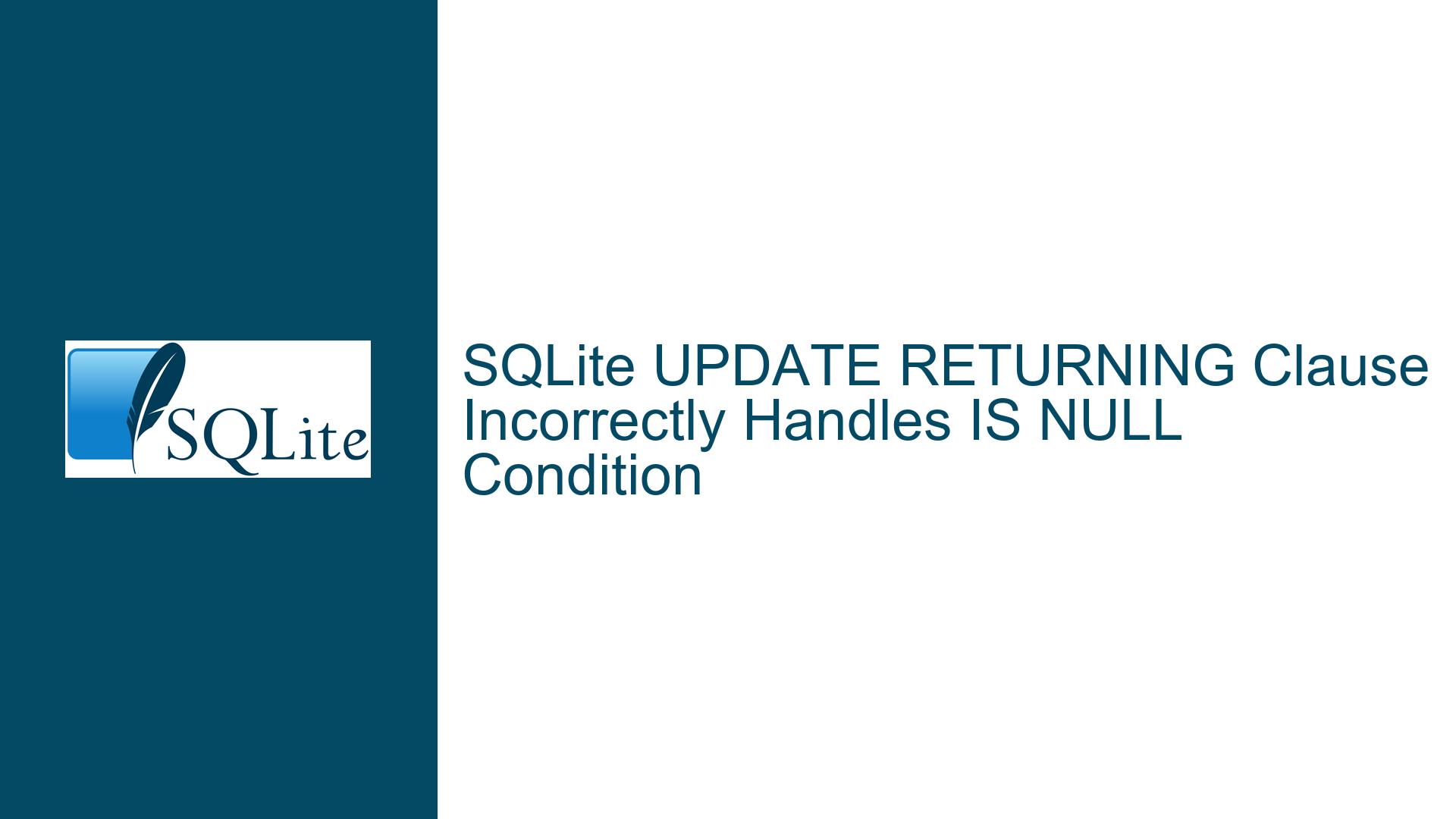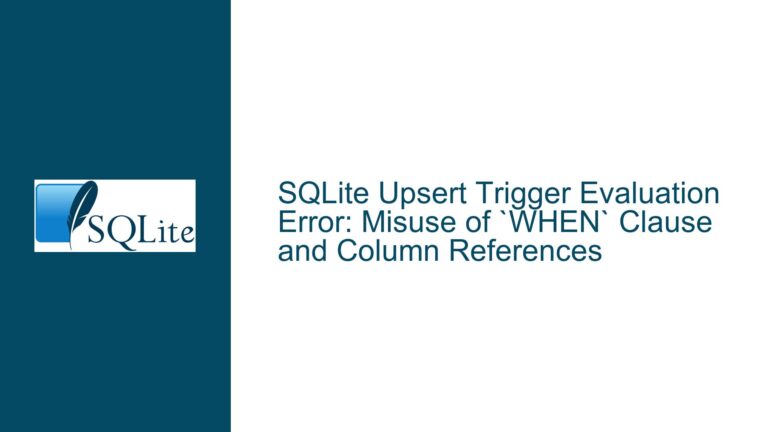SQLite UPDATE RETURNING Clause Incorrectly Handles IS NULL Condition
Issue Overview: Incorrect IS NULL Evaluation in UPDATE RETURNING Clause
The core issue revolves around the incorrect evaluation of the IS NULL condition within the RETURNING clause of an UPDATE statement in SQLite. Specifically, when updating a column to NULL and attempting to return the result of an IS NULL check on that column, SQLite erroneously returns 0 (false) instead of 1 (true). This behavior was introduced in SQLite version 3.38 and was not present in earlier versions.
To illustrate the problem, consider the following table definition and data insertion:
CREATE TABLE bug (
id INTEGER PRIMARY KEY AUTOINCREMENT NOT NULL,
description VARCHAR(255) DEFAULT NULL
);
INSERT INTO bug (id, description) VALUES (20, NULL);
When executing the following UPDATE statement:
UPDATE bug
SET description = NULL
WHERE id = 20
RETURNING description IS NULL;
SQLite returns 0 (false) for the description IS NULL condition, even though the description column is explicitly set to NULL. This is incorrect behavior, as the description column should indeed be NULL, and the IS NULL check should return 1 (true).
The issue was traced back to the presence of a redundant NOT NULL constraint on the id column, which is an INTEGER PRIMARY KEY. Although the NOT NULL constraint on the id column is redundant (since INTEGER PRIMARY KEY columns are inherently NOT NULL), it appears to interfere with the RETURNING clause’s handling of the IS NULL condition on the description column. This suggests a potential optimization bug in SQLite’s query processing logic, where the NOT NULL constraint on one column inadvertently affects the evaluation of IS NULL on another column.
Possible Causes: Redundant NOT NULL Constraint and Query Optimization
The primary cause of this issue lies in the interaction between the redundant NOT NULL constraint on the id column and SQLite’s query optimization logic. The INTEGER PRIMARY KEY column in SQLite is inherently NOT NULL, meaning that any attempt to insert or update this column with a NULL value will result in an error. Therefore, explicitly adding a NOT NULL constraint to an INTEGER PRIMARY KEY column is redundant and does not provide any additional integrity guarantees.
However, in this case, the presence of the redundant NOT NULL constraint on the id column appears to trigger a bug in SQLite’s query optimization logic. Specifically, the optimizer seems to mistakenly apply the NOT NULL constraint to the description column when evaluating the IS NULL condition in the RETURNING clause. This leads to the incorrect result of 0 (false) for the description IS NULL condition, even though the description column is explicitly set to NULL.
The bug was introduced in SQLite version 3.38, indicating that a change in the query optimization logic in this release inadvertently introduced this issue. The problem was identified through a bisect process, which traced the bug’s introduction to a specific range of commits in the SQLite source code. However, the initial bisect results were misleading, and further investigation revealed the true cause of the issue.
Troubleshooting Steps, Solutions & Fixes: Workarounds and Official Fixes
To address this issue, several steps can be taken, ranging from temporary workarounds to applying the official fix provided by the SQLite development team.
Workaround: Remove Redundant NOT NULL Constraint
The simplest workaround is to remove the redundant NOT NULL constraint from the id column. Since the id column is an INTEGER PRIMARY KEY, it is already guaranteed to be NOT NULL, and the explicit NOT NULL constraint is unnecessary. By removing this constraint, the incorrect behavior in the RETURNING clause is avoided.
Here is the modified table definition without the redundant NOT NULL constraint:
CREATE TABLE bug (
id INTEGER PRIMARY KEY AUTOINCREMENT,
description VARCHAR(255) DEFAULT NULL
);
With this change, the UPDATE statement with the RETURNING clause will correctly return 1 (true) for the description IS NULL condition:
UPDATE bug
SET description = NULL
WHERE id = 20
RETURNING description IS NULL;
This workaround is effective in avoiding the bug but does not address the underlying issue in SQLite’s query optimization logic.
Official Fix: Apply the Latest SQLite Update
The SQLite development team has addressed this issue in the latest versions of SQLite. The bug was fixed in the trunk (main development branch) and backported to the 3.40 branch. Users experiencing this issue should update to the latest version of SQLite that includes the fix.
To apply the official fix, follow these steps:
Download the Latest SQLite Version: Visit the SQLite Download Page and download the latest precompiled binaries or source code for your platform.
Install the Updated Version: Replace your current SQLite installation with the updated version. Ensure that your application or environment is configured to use the new version of SQLite.
Verify the Fix: After updating, re-run the
UPDATEstatement with theRETURNINGclause to confirm that theIS NULLcondition is now correctly evaluated:
UPDATE bug
SET description = NULL
WHERE id = 20
RETURNING description IS NULL;
The result should now be 1 (true), indicating that the description column is correctly recognized as NULL.
Detailed Explanation of the Fix
The fix involves correcting the query optimization logic in SQLite to ensure that the NOT NULL constraint on one column does not inadvertently affect the evaluation of IS NULL conditions on other columns. The SQLite development team identified that the optimizer was mistakenly applying the NOT NULL constraint from the id column to the description column, leading to the incorrect result.
By refining the optimization logic, the fix ensures that the IS NULL condition is evaluated independently of any NOT NULL constraints on other columns. This restores the correct behavior and prevents similar issues from arising in the future.
Preventative Measures: Best Practices for Schema Design
To avoid encountering similar issues in the future, it is important to follow best practices for schema design in SQLite:
Avoid Redundant Constraints: Do not add redundant constraints, such as
NOT NULLon anINTEGER PRIMARY KEYcolumn. These constraints do not provide any additional integrity guarantees and can potentially interfere with query optimization.Keep Schema Definitions Simple: Use only the necessary constraints and indexes in your table definitions. Overly complex schema definitions can lead to unintended interactions and bugs in the query optimizer.
Test Thoroughly: After making changes to your schema or updating SQLite, thoroughly test your queries to ensure that they behave as expected. This is especially important when using advanced features like the
RETURNINGclause.Stay Updated: Regularly update to the latest version of SQLite to benefit from bug fixes and performance improvements. The SQLite development team actively maintains the software and releases updates to address issues and enhance functionality.
Conclusion
The issue with the incorrect evaluation of the IS NULL condition in the UPDATE RETURNING clause in SQLite is a result of a bug in the query optimization logic, triggered by a redundant NOT NULL constraint on an INTEGER PRIMARY KEY column. By removing the redundant constraint or updating to the latest version of SQLite, users can resolve this issue and ensure correct query behavior. Following best practices for schema design and staying updated with the latest SQLite releases will help prevent similar issues in the future.






